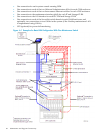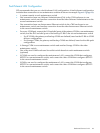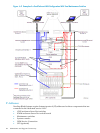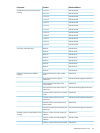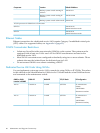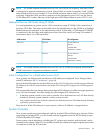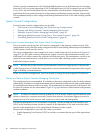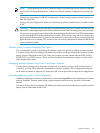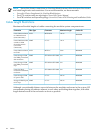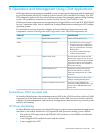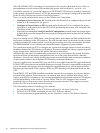
System consoles communicate with NonStop BladeSystems over a dedicated service local area
network (LAN) or a secure operations LAN. A dedicated service LAN is required for use of OSM
Low-Level Link and Notification Director functionality, which includes configuring primary
and backup dial-out points (referred to as the primary and backup system consoles, respectively).
HP recommends that you also configure the backup dedicated service LAN with a backup system
console.
System Console Configurations
Several system console configurations are possible:
• “One System Console Managing One System (Setup Configuration)”
• “Primary and Backup System Consoles Managing One System”
• “Multiple System Consoles Managing One System” (page 91)
• “Managing Multiple Systems Using One or Two System Consoles” (page 91)
• “Cascading Ethernet Switch or Hub Configuration” (page 91)
One System Console Managing One System (Setup Configuration)
The one system console on the LAN must be configured as the primary system console. This
configuration can be called the setup configuration and is used during initial setup and installation
of the system console and the server.
The setup configuration is an example of a secure, stand-alone network as shown in Figure 6-1
(page 82). A LAN cable connects the primary system console to the maintenance switch, and
additional LAN cables connect the switches and Ethernet ports. The maintenance switch or an
optional second maintenance switch allows you to later add a backup system console and
additional system consoles.
NOTE: Because the system console and maintenance switch are single points of failure that
could disrupt access to OSM, this configuration is not recommended for operations that require
high availability or fault tolerance.
When you use this configuration, you do not need to change the preconfigured IP addresses.
Primary and Backup System Consoles Managing One System
This configuration is recommended. It is similar to the setup configuration, but for fault-tolerant
redundancy, it includes a second maintenance switch, backup system console, and second modem
(if a modem-based remote solution is used). The maintenance switches provide a dedicated LAN
in which all systems use the same subnet. Figure 6-2 (page 84)shows a fault-tolerant configuration
without modems.
NOTE: A subnet is a network division within the TCP/IP model. Within a given network, each
subnet is treated as a separate network. Outside that network, the subnets appear as part of a
single network. The terms subnet and subnetwork are used interchangeably.
If a remote maintenance LAN connection is required, use the second network interface card
(NIC) in the NonStop system console to connect to the operations LAN, and access the other
devices in the maintenance LAN using Remote Desktop via the console.
Because this configuration uses only one subnet, you must:
• Enable Spanning Tree Protocol (STP) in switches or routers that are part of the operations
LAN.
90 Maintenance and Support Connectivity



